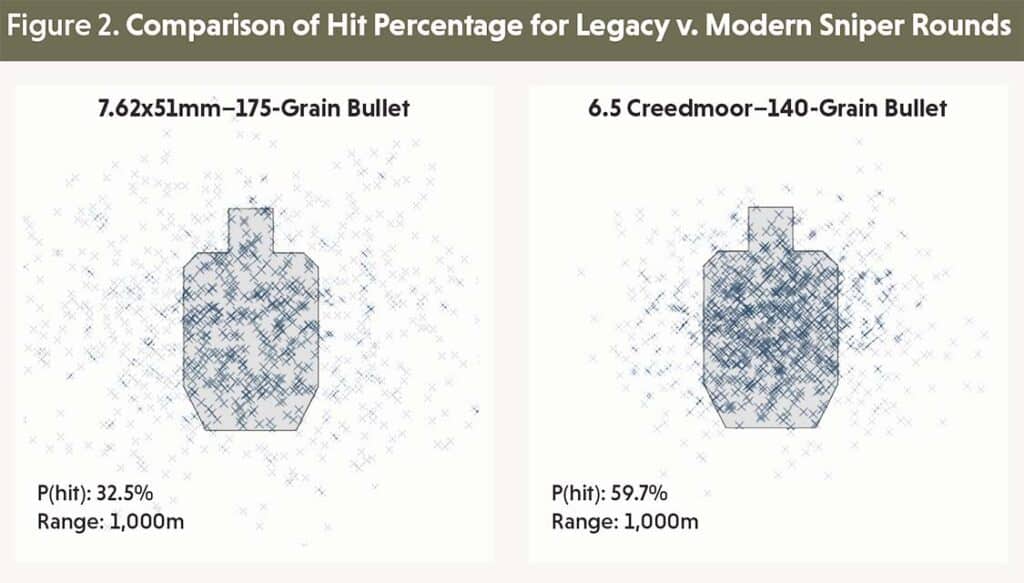By Bryan Litz
Since the beginning of armed conflict, the army with the greatest stand-off range held a strategic advantage over their enemies. This applies from tanks and artillery to small arms. This article is a brief overview of some of the recent advancements in ammunition which have increased the maximum effective range of modern snipers.
The 7.62x51mm (.308 Winchester) cartridge and M118LR ammunition (175-grain bullet) has been in heavy use in recent decades. Snipers and designated marksmen have employed this round in rifles such as the M24 bolt action and M110 semi-automatic rifles. Improved performance was available with the .300 Winchester Magnum in the M24 or the more modern M2010 variant which fires a slightly heavier 190-grain bullet at a higher velocity. At the high end, the .338 Lapua Magnum cartridge has been used for range-maximizing performance.
The very latest developments in sniper ammo technology have moved away from the cartridges and bullets that have been used for many decades. There are good technical reasons for these changes, which we’ll now explore.

From .308 to .264 Caliber
The 7.62x51mm-round-firing M118 LR (.308 caliber firing a 175-grain bullet) has been a reliably accurate mainstay for snipers and designated marksmen. Recently these roles have moved to a smaller caliber; the 6.5mm Creedmoor. Why the change and why now?
Despite the advantages of the 7.62x51mm, its ballistic performance is quite poor. The muzzle velocity of the 175-grain projectile can be in the low 2500fps range from barrels that keep getting shorter due to more weapons being fitted with suppressors and the desire for overall shorter rifles. In addition to low-muzzle velocity, the Ballistic Coefficient (BC) of the bullet is very low compared to other options.
The 6.5 Creedmoor cartridge fires a higher BC bullet at a higher muzzle velocity, out of the same length and weight platform. This is the main reason for the change from .308 to 6.5mm.
To get technical about how the smaller cartridge is able to achieve higher performance from the same platform, consider Figure 1. There are 2 major items that affect performance when you scale down the caliber of a cartridge.
1) You can use a bullet that is proportionally longer and maintain the same Cartridge Over All Length (COAL) of the round for magazine feeding. Bullets that are proportionally longer typically have higher Sectional Density (SD) and lower drag profiles which both contribute to higher BC.
2) The ratio of powder-to-bullet mass is higher in the smaller caliber round. This directly results in higher muzzle velocity in the same length barrel.

In summary, the 7.62x51mm round fires a 175-grain bullet with a G7 BC of 0.243 at about 2500fps in a 20-inch barrel. Using the same magazines and barrel length, a similar rifle chambered in 6.5 Creedmoor fires a 140-grain bullet with a G7 BC of 0.311 at about 2700fps (see Table 1).
The performance benefits of the smaller round are obvious in ballistic terms, but how does that translate into effectiveness on the battlefield? In other words, how much higher is the hit percentage for the modern versus legacy rounds? Figure 2 shows a comparison of the hit percentage for the two rounds on a man-sized target at 1,000 meters.
Figure 2 shows that the modern round achieves nearly double the hit percentage on the same 1,000-meter target. This dramatic increase in hit percentage is achieved strictly through a ballistic performance advantage. In the Weapon Employment Zone (WEZ) model used to calculate hit percentage, both scenarios assume a 1 MOA rifle and nominal uncertainties in wind and range (standard deviations of 1 mph and 5 meters). In other words, the higher ballistic performance translates to less drop and wind deflection in the same environment. So when there are uncertainties in the environment, the higher performance round isn’t affected as much.
Why Now?
Given how much of an advantage the smaller 6.5 Creedmoor round provides over the 7.62x51mm, the obvious question is why did it take so long for this advancement to occur, and why now?
It’s not because we were ignorant of the ballistic advantages. The truth is, the manufacturing quality hasn’t always been good enough to make this jump without compromising precision.
In short, the challenges of moving to a smaller caliber round in the past have been related to compromised precision, due to limitations in precision manufacturing of bullets combined with faster twist rates required to stabilize them.
Modern manufacturing methods employed by industry leaders have overcome these challenges and are now capable of making proportionally long bullets with good enough balance to provide excellent precision, even in the faster twist barrels. We can now enjoy improved performance without compromising precision.
The same trend from 7.62x51mm to 6.5 Creedmoor has occurred for larger sniper rounds as well. We see all the same benefits when moving from .338 Lapua Magnum with 250-grain bullets to .300 Norma Magnum with 215-grain bullets. The .300 Norma Mag fires a higher BC bullet at a higher muzzle velocity than the .338 Lapua Magnum which results in greater hit percentage at long range. The .300 Norma requires a faster twist rate (1:8 inch) than the .338 Lapua (1:12 inch), but thanks to modern manufacturing this is no longer an issue for precision.
What’s Next?
Most of this article has been about the improvements in ballistic performance of modern sniper ammo. Where do we go from here? How will we continue to improve snipers’ hit percentages at long ranges?
The Assistant Secretary of Defense for Special Operations/Low-Intensity Conflict (ASD/SOLIC) and Combating Terrorism Technical Support Office (CTTSO) fund technology advancements which increase lethality and survivability across DOD. Recently, CTTSO has slated funding for Applied Ballistics, LLC, to conduct an R&D program called “Super Match Grade Marksmanship Ammunition” (SMGMA) with the goal of improving the consistency of muzzle velocity and BC. High performance sniper ammo is great, but with all the modern advancements in range finding, ballistic solvers and wind reading instruments, the actual shot-to-shot consistency of the ammunition has become the weak link. Through the SMGMA initiative, CTTSO and Applied Ballistics hope to improve further on modern sniper effectiveness through a quantum leap in ammunition consistency beginning in FY20 and completing in FY21.
| Table 1. Comparison of Legacy vs. Modern Medium Caliber Sniper Rounds | ||
| Cartridge – Bullet | MV | G7 BC |
| 7.62x51mm – .308 caliber 175 grain | 2500 fps | 0.243 |
| 6.5 Creedmoor – 0.264 caliber 140 grain | 2700 fps | 0.311 |
| Difference | +200 fps | +28% |
| This article first appeared in Small Arms Review V24N2 (Feb 2020) |












